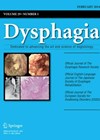
Journal Reviews
Analysing videofluroscopy: does it matter how it’s done?
Videofluoroscopy, as a tool that assesses the process of swallowing, has transformed our understanding of dysphagia. Clinicians can observe the biomechanics of a bolus moving from the oral cavity through the pharynx and oesophagus and into the stomach. Over the...
CI outcome measures and different languages
Outcome measures for hearing rehabilitation strategies in children are the subject of endless debate. The underlying problem with measuring outcomes in this population is delineating the extent to which development (which is in itself variable) and hearing ability (usually the...
Standardising videofluoroscopy assessment for bottle-fed babies
Swallowing problems in babies may occur for many reasons including complex medical problems, premature birth, and low birth-weight. Dysphagia causes several further morbidities such as poor nutrition and compromised respiration, often raising distress for both infants and their caregivers. Early...
Wearable sensors for assessment of vestibular disorders
This prospective preliminary study describes the use of commercially available wearable inertial sensors (Mobility LabTM) in assessing the functional ability of individuals with vestibular disorders. Traditionally the Romberg’s, Tandem Walking and Fukuda’s Stepping tests were used to clinically evaluate individuals...









